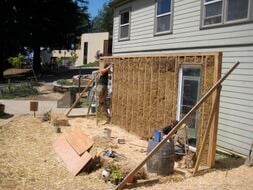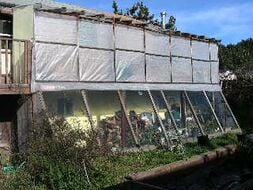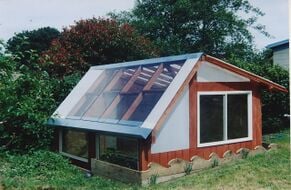
A greenhouse is a structure that allows people to regulate climatic conditions, such as temperature and humidity, to create an optimal environment for plant growth. Greenhouses can be used for a variety of purposes, from growing food to cultivating ornamental plants. On this page, you will find information on different types of greenhouses, their construction, and how to use them sustainably.
Greenhouses are one (expensive) way of growing under cover.
- Greenhouse redirects here. For information on the greenhouse effect, see Global warming.
Types[edit | edit source]
Cold Frame[edit | edit source]

A cold frame (also known as a hotbed) is a way of growing young plants during the cold end of winter or start of spring, keeping them warm to give them a chance to survive and thrive despite the cold. A cold frame consists of a wooden box with a glass lid that can be opened and closed with ease. The cold frame acts as a mini greenhouse which can be opened to take advantage of the day's heat and closed to keep the warmth in at night.
Cloche[edit | edit source]

A cloche, French for "bell", is a miniature greenhouse that can be placed directly over plants.
A DIY cloche can be made from a plastic bottle; alternatively, just the bottom can be cut off and the top pressed into the ground, providing warmth and protection for seedlings. In cold climates this allows seeds to be planted a few weeks earlier. The cap may be used for further control - remove it in warm weather, replace it at nights. A simpler way is to leave it off entirely - this will still offer some protection (though not as much) while needing less attention (and less concern about letting the seedlings overheat by leaving the cap on during a warm day). Further info: An internet search for plastic-bottle miniature-greenhouse yields many relevant hits.
Plastic bottle greenhouse[edit | edit source]

It is possible to build viable greenhouses with only the following construction materials:
- Plastic bottles
- Structural material (timber, brick, etc)
- Wire, or resilient cord
- Fasteners (nails/screws)
Seawater Greenhouses[edit | edit source]

Seawater greenhouse is a new form of technology, invented by Charlie Paton that can help to address water scarcity and quality problems. So far this form of technology has only been implemented in a handful of pilot systems around the world and all of these are still currently in progress; however, they show extremely high promise in the areas they have been deployed and give hope for the struggles of the people living in arid lands. Currently, there is no determined limit to the applications or the lifetime of the greenhouses. Thus, seawater greenhouses are not applicable everywhere.
Seawater greenhouses vary a fair amount from the conventional Dutch greenhouses, which is what the public normally associates greenhouses with. The differences though, are pretty astounding as they work in similar, but much more sustainable ways. They can be cheaper than the standard Dutch Greenhouse, they provide free water with no upkeep costs and without running into the carbon dioxide constrictions that Dutch greenhouses typically run into.
Chinese Solar Greenhouse[edit | edit source]

There is a special type of solar greenhouse that is common in China but largely unknown in the rest of the world. The concept originated in the 1970s and 80s and has been promoted by the government in China. To maximize solar heat collection, the greenhouse is facing south but has solid walls on its north (back), east and west side. Another feature is that it can be covered with insulating material at night (straw mats, other), which is then rolled up again in the morning. Most of these greenhouses do not require extra heating during the cold season, yet still manage to avoid freezing temperatures. The precise geometric configuration depends on latitude. All sorts of variations exist, from very low-tech, build-it-yourself versions with simple materials (bricks, rammed earth, bamboo, etc.) to very high-tech versions (steel, ventilation). The articles linked below, especially the one from Low-Tech Magazine, have much more information and photos.
Related projects[edit | edit source]
Project examples[edit | edit source]
1 million pounds of food on 3 acres[edit | edit source]
- 10,000 fish
- 300-500 yards worm compost
- 3 acres of land in green houses
- Grow all year using heat from compost piles.
- Using vertical space
- Simple 1 pump aquaponics
A packed greenhouse produces a crop value of $5 Square Foot! ($200,000/acre). That is if the whole acre was under greenhouse.
See also[edit | edit source]
- Construction of an Affordable Greenhouse
- Plastic bottle greenhouse
- Kiva's straw bale greenhouse: actually more akin to a conservatory, atleast if people were to use the construction as a house
- Humboldt greenhouse gallery
- The Food and Heat Producing Solar Greenhouse
External links[edit | edit source]
- Greenhouses forum at Permies.com
- Wikipedia:Greenhouses
- Official "Earth Sheltered Solar Greenhouse" - pit constructionat Paul Wheaton's You Tube Channel
- greenhouse construction + rocket mass heater how to tutorial at Paul Wheaton's You Tube Channel
- Backyard Greenhouse Kits
- Small Greenhouse Kits
- Alt om din bolig
- Sport



















